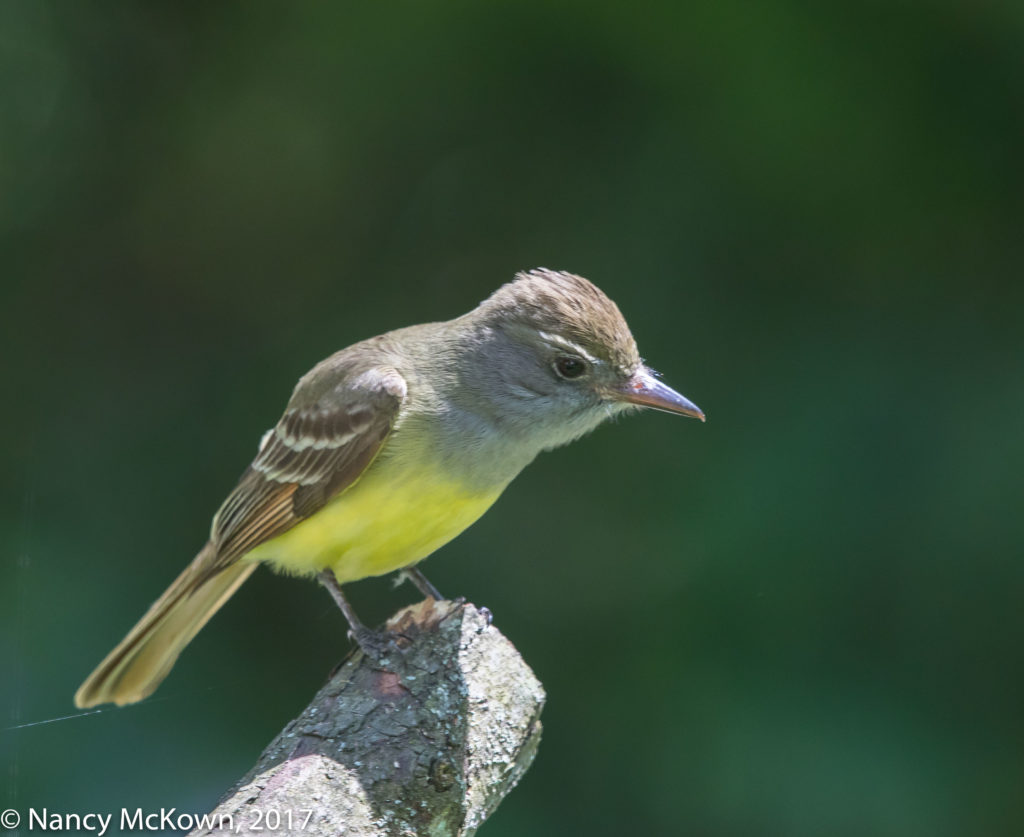Photographing the Great Crested Flycatcher
This little Great Crested Flycatcher is a new bird for me. My bird books note that this species is a common neotropical migrant which nests in South West MI and a wide swath of the Eastern United States. The plumage on the males and females looks identical… gray and reddish brown feathers accented with a lemon yellow belly. There’s not much of a crest….let alone a “great crest” on this bird’s somewhat oversized head.
There are so many look-alike species of flycatchers that it is gratifying to photograph one that looks so distinctive and can be easily identified. When I spotted him, I wasn’t quite to the point where I was going to put the camera away, but the windows had been shut, indicating that quality of light and my expectations had seriously dwindled. He perched right near my dirty window. I could not risk cranking the window open, so I took the shot through it, knowing that sharpness and detail would be subpar in the resulting image. After he flew off, I opened the window and waited for approximately 30 minutes, this time with my camera at the ready. He did not come back.

Mid day Harsh Light
Somewhat tempered
in Post Processing.
ISO1250; f/8; 1/250 Second
Nest Adornment
These secondary cavity nesters make their homes in decomposing standing deadwood (SNAGS), frequently in the remains of holes made and abandoned by woodpeckers. They prefer to reside high in the leafy tree canopies and eat a wide assortment of insects -often snatching them in mid air. A quirky habit of the Great Crested Flycatcher is that they often add a scaly shed snakeskin adornment to its nest. If it can’t find that, it may substitute pieces of crinkly paper or plastic. This makes me wonder why some birds go through the trouble of decorating their nests. Is it genetic or cultural, meant to draw attention or hide something? Is it an attempt to accessorize, or is it just meaningless adornment? Whatever, it is fascinating.
Repairing Image Highlights in Lightroom
The midday sun was creating harsh shadows when I took this photo. The histogram in Lightroom indicated that some of the highlights in the image (above) were overly bright, but not irretrievably clipped or blown out. (NOTE: You can tell there’s no clipping if the Lightroom clipping warning triangle to the right of the histogram is black.) This meant that I would be able to bring back most of the image detail by reducing the highlights… (ie.moving the highlight slider to the left). After a little time in post processing, the resulting image is not as bad as I thought it would be.
Vagrant?
When I first spotted this Great Creasted Flycatcher, I secretly hoped that he was an off-course vagrant. He is not. No doubt he is just one of many bird species who lives high above in the tree canopy and rarely makes an appearance. (NOTE: “A bird is considered vagrant if it strays far outside its expected breeding, wintering or migrating range. The key factor in defining vagrant is the distance – a bird that is just barely outside its normal range is not usually considered vagrant, but a bird found hundreds of miles from its familiar territory is a vagrant.”)









Very interesting blog. I love the part about the snakeskin!